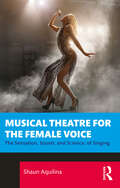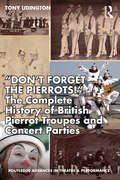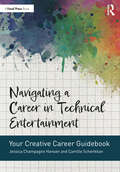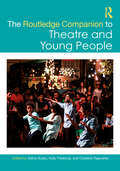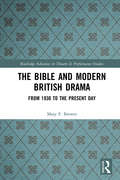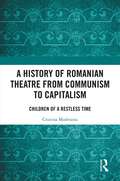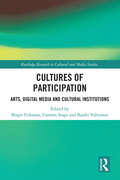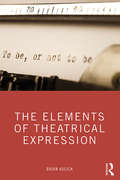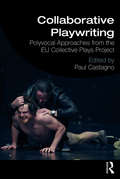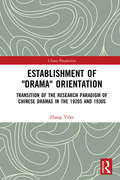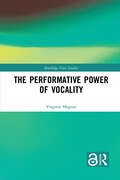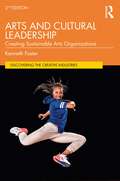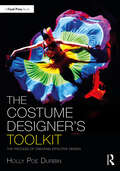- Table View
- List View
Musical Theatre for the Female Voice: The Sensation, Sound, and Science, of Singing
by Shaun AquilinaFemale musical theatre singers produce some of the most exciting and expressive singing an audience can experience. They also face a unique and specific set of issues when approaching their craft, from negotiating the registers of their voice to enable them to belt, to vocal health challenges such as premenstrual voice syndrome. This is the only book that offers a full and detailed guide to tackling those issues and to singing with full expression and technical excellence. Musical Theatre for the Female Voice covers the origin of singing in musicals, from the bel canto style of 300 years ago through to the latest developments in high belting, in shows such as Wicked and Waitress. It offers the reader exercises and methods that have been used to train hundreds of singers at some of the UK’s leading musical theatre training institutions and are underpinned by the latest academic research in journals on singing, psychology, and health. Every element of a singer's toolkit is covered from a female perspective, from breath and posture to character work and vocal health. This is an essential guidebook for female singers in musical theatre productions, either training at university or conservatory level or forging a career as professional triple-threat performers.
Musical Theatre for the Female Voice: The Sensation, Sound, and Science, of Singing
by Shaun AquilinaFemale musical theatre singers produce some of the most exciting and expressive singing an audience can experience. They also face a unique and specific set of issues when approaching their craft, from negotiating the registers of their voice to enable them to belt, to vocal health challenges such as premenstrual voice syndrome. This is the only book that offers a full and detailed guide to tackling those issues and to singing with full expression and technical excellence. Musical Theatre for the Female Voice covers the origin of singing in musicals, from the bel canto style of 300 years ago through to the latest developments in high belting, in shows such as Wicked and Waitress. It offers the reader exercises and methods that have been used to train hundreds of singers at some of the UK’s leading musical theatre training institutions and are underpinned by the latest academic research in journals on singing, psychology, and health. Every element of a singer's toolkit is covered from a female perspective, from breath and posture to character work and vocal health. This is an essential guidebook for female singers in musical theatre productions, either training at university or conservatory level or forging a career as professional triple-threat performers.
“Don’t Forget The Pierrots!'' The Complete History of British Pierrot Troupes & Concert Parties (Routledge Advances in Theatre & Performance Studies)
by Tony LidingtonThis volume is the first authoritative historical textbook to look at the origins, development and evolution of seaside pierrot troupes and concert parties and their popular performance heritage. It will provide, for the first time, a definition of the pierrot troupe and its evolution from the roots of European popular traditions such as the commedia dell’arte and minstrelsy, to links between music hall and contemporary popular culture. Tony Lidington will explore how pierrot troupes grew from a single idea into a major international cultural industry and how it boosted morale and national identity during the two World Wars, before sublimating into contemporary pop music and comedy. Tony’s continuing practice as research provides an experiential framework for the historical and ethnographic analysis of the form. This book will be of vital interest to students, researchers, and performers of outdoor (al fresco) arts, clowning and comedy, minstrelsy, vernacular music-making and music hall.
“Don’t Forget The Pierrots!'' The Complete History of British Pierrot Troupes & Concert Parties (Routledge Advances in Theatre & Performance Studies)
by Tony LidingtonThis volume is the first authoritative historical textbook to look at the origins, development and evolution of seaside pierrot troupes and concert parties and their popular performance heritage. It will provide, for the first time, a definition of the pierrot troupe and its evolution from the roots of European popular traditions such as the commedia dell’arte and minstrelsy, to links between music hall and contemporary popular culture. Tony Lidington will explore how pierrot troupes grew from a single idea into a major international cultural industry and how it boosted morale and national identity during the two World Wars, before sublimating into contemporary pop music and comedy. Tony’s continuing practice as research provides an experiential framework for the historical and ethnographic analysis of the form. This book will be of vital interest to students, researchers, and performers of outdoor (al fresco) arts, clowning and comedy, minstrelsy, vernacular music-making and music hall.
Navigating a Career in Technical Entertainment: Your Creative Career Guidebook
by Jessica Champagne Hansen Camille SchenkkanNavigating a Career in Technical Entertainment: Your Creative Career Guidebook explores tools, strategies, and motivational advice from a wide range of industry professionals for navigating an artistic career in design and technology in entertainment. This book is designed to accompany readers every step of the way in their career journey – from landing their first job after school through mid-career pivots and switching industries. It is organized into four parts: Finding Your Career Path; Tools and Strategies for Navigating Your Career Path; Curating a Creative Community as You Sustain Your Career; and Maintaining Flexibility and Finding Fulfillment in Your Career. Filled with motivational advice from mentors in the industry and creative worksheet exercises for personalized career planning, self- reflection, and goal setting, this book demystifies a complex industry, sharing crucial career-related information rarely covered in formal training programs. It explores a wide range of topics, including the types of jobs available in live entertainment and TV/film, education options, job searching, networking, career marketing materials, interviews, unions, financial empowerment, and refocusing on career shifts. This guidebook is written for designers, technicians, stage managers, production managers, crew members, and creative technical artists in entertainment at all stages of their career. Covering a wide variety of entertainment from theater and television to commercials and theme parks, Navigating a Career in Technical Entertainment is a perfect companion for higher education or postsecondary educators and students exploring career and workforce readiness topics and can also be used by professionals actively working in the field. This text also includes access to downloadable versions of the worksheets featured in the book, available at www.routledge.com/9780367510442.
Navigating a Career in Technical Entertainment: Your Creative Career Guidebook
by Jessica Champagne Hansen Camille SchenkkanNavigating a Career in Technical Entertainment: Your Creative Career Guidebook explores tools, strategies, and motivational advice from a wide range of industry professionals for navigating an artistic career in design and technology in entertainment. This book is designed to accompany readers every step of the way in their career journey – from landing their first job after school through mid-career pivots and switching industries. It is organized into four parts: Finding Your Career Path; Tools and Strategies for Navigating Your Career Path; Curating a Creative Community as You Sustain Your Career; and Maintaining Flexibility and Finding Fulfillment in Your Career. Filled with motivational advice from mentors in the industry and creative worksheet exercises for personalized career planning, self- reflection, and goal setting, this book demystifies a complex industry, sharing crucial career-related information rarely covered in formal training programs. It explores a wide range of topics, including the types of jobs available in live entertainment and TV/film, education options, job searching, networking, career marketing materials, interviews, unions, financial empowerment, and refocusing on career shifts. This guidebook is written for designers, technicians, stage managers, production managers, crew members, and creative technical artists in entertainment at all stages of their career. Covering a wide variety of entertainment from theater and television to commercials and theme parks, Navigating a Career in Technical Entertainment is a perfect companion for higher education or postsecondary educators and students exploring career and workforce readiness topics and can also be used by professionals actively working in the field. This text also includes access to downloadable versions of the worksheets featured in the book, available at www.routledge.com/9780367510442.
The Routledge Companion to Theatre and Young People (Routledge Companions)
by Selina Busby Kelly Freebody Charlene RajendranThis companion interrogates the relationship between theatre and youth from a global perspective, taking in performances and theatre made by, for, and about young people. These different but interrelated forms of theatre are addressed through four critical themes that underpin the ways in which analysis of contemporary theatre in relation to young people can be framed: political utterances – exploring the varied ways theatre becomes a platform for political utterance as a process of dialogic thinking and critical imagining; critical positioning – examining youth theatre work that navigates the sensitive, dynamic, and complex terrains in which young people live and perform; pedagogic frames – outlining a range of contexts and programmes in which young people learn to make and understand theatre that reflects their artistic capacities and aesthetic strategies; applying performance – discussing a range of projects and companies whose work has been influential in the development of youth theatre within specific contexts. Providing critical, research-informed, and research-based discussions on the intersection between young people, their representation, and their participation in theatre, this is a landmark text for students, scholars, and practitioners whose work and thinking involves theatre and young people.
The Routledge Companion to Theatre and Young People (Routledge Companions)
by Selina Busby Kelly Freebody Charlene RajendranThis companion interrogates the relationship between theatre and youth from a global perspective, taking in performances and theatre made by, for, and about young people. These different but interrelated forms of theatre are addressed through four critical themes that underpin the ways in which analysis of contemporary theatre in relation to young people can be framed: political utterances – exploring the varied ways theatre becomes a platform for political utterance as a process of dialogic thinking and critical imagining; critical positioning – examining youth theatre work that navigates the sensitive, dynamic, and complex terrains in which young people live and perform; pedagogic frames – outlining a range of contexts and programmes in which young people learn to make and understand theatre that reflects their artistic capacities and aesthetic strategies; applying performance – discussing a range of projects and companies whose work has been influential in the development of youth theatre within specific contexts. Providing critical, research-informed, and research-based discussions on the intersection between young people, their representation, and their participation in theatre, this is a landmark text for students, scholars, and practitioners whose work and thinking involves theatre and young people.
The Bible and Modern British Drama: From 1930 to the Present Day (Routledge Advances in Theatre & Performance Studies)
by Mary F. BrewerThe Bible and Modern British Drama: 1930 to the Present Day is the first full-length study to explore how playwrights in the modern period have adapted popular biblical stories, such as Abraham and Isaac, Moses and the Exodus from Egypt, and the life and death of Jesus, for the stage. The book offers detailed and accessible interpretations of the work of well-known dramatists such as Christopher Fry, Howard Brenton, and Steven Berkoff, alongside the work of writers whose plays have been neglected in recent criticism, such as James Bridie and Laurence Housman. The drama is analysed within the context of changes in religious belief and practice over the course of the modern period in Britain, comparing plays that approach the Bible from a traditional religious perspective with those that offer alternative viewpoints on the text, including the voices of gay, feminist, black, Jewish, and Muslim dramatists. In doing so, the author offers a broad and in-depth exploration that is grounded in current scholarship, ranging from the past to present, across boundaries of race and gender. Ideal for students, researchers, and general readers interested in understanding how the Bible has served as an important source text for British playwrights in the twentieth and twenty-first centuries, The Bible and Modern British Drama shows how Bible-based drama has been influential in creating and disseminating ideas of what constitutes a "good" life, both on an individual and social level.
The Bible and Modern British Drama: From 1930 to the Present Day (Routledge Advances in Theatre & Performance Studies)
by Mary F. BrewerThe Bible and Modern British Drama: 1930 to the Present Day is the first full-length study to explore how playwrights in the modern period have adapted popular biblical stories, such as Abraham and Isaac, Moses and the Exodus from Egypt, and the life and death of Jesus, for the stage. The book offers detailed and accessible interpretations of the work of well-known dramatists such as Christopher Fry, Howard Brenton, and Steven Berkoff, alongside the work of writers whose plays have been neglected in recent criticism, such as James Bridie and Laurence Housman. The drama is analysed within the context of changes in religious belief and practice over the course of the modern period in Britain, comparing plays that approach the Bible from a traditional religious perspective with those that offer alternative viewpoints on the text, including the voices of gay, feminist, black, Jewish, and Muslim dramatists. In doing so, the author offers a broad and in-depth exploration that is grounded in current scholarship, ranging from the past to present, across boundaries of race and gender. Ideal for students, researchers, and general readers interested in understanding how the Bible has served as an important source text for British playwrights in the twentieth and twenty-first centuries, The Bible and Modern British Drama shows how Bible-based drama has been influential in creating and disseminating ideas of what constitutes a "good" life, both on an individual and social level.
A History of Romanian Theatre from Communism to Capitalism: Children of a Restless Time
by Cristina ModreanuA History of Romanian Theatre from Communism to Capitalism analyses the last three decades of Romanian theatre and connects it to the international stage. Cristina Modreanu questions the relationship between artists and power, both before 1989, behind the Iron Curtain, and in the current global political context, with nationalism manifesting itself in Eastern Europe, as seen in the critical work of Romanian theatre makers. This study covers the complex cases of theatre makers such as Lucian Pintilie, Liviu Ciulei and Andrei Șerban, who built their international careers in exile, and the most innovative Romanian artists of today, such as Silviu Purcărete, Mihai Măniuţiu, Gianina Cărbunariu, Radu Afrim, and Bogdan Georgescu, who reached the status of transglobal artists. Filling a considerable gap in Romanian theatre discourse, this book will be of a great interest to students and scholars of contemporary theatre and history.
A History of Romanian Theatre from Communism to Capitalism: Children of a Restless Time
by Cristina ModreanuA History of Romanian Theatre from Communism to Capitalism analyses the last three decades of Romanian theatre and connects it to the international stage. Cristina Modreanu questions the relationship between artists and power, both before 1989, behind the Iron Curtain, and in the current global political context, with nationalism manifesting itself in Eastern Europe, as seen in the critical work of Romanian theatre makers. This study covers the complex cases of theatre makers such as Lucian Pintilie, Liviu Ciulei and Andrei Șerban, who built their international careers in exile, and the most innovative Romanian artists of today, such as Silviu Purcărete, Mihai Măniuţiu, Gianina Cărbunariu, Radu Afrim, and Bogdan Georgescu, who reached the status of transglobal artists. Filling a considerable gap in Romanian theatre discourse, this book will be of a great interest to students and scholars of contemporary theatre and history.
Cultures of Participation: Arts, Digital Media and Cultural Institutions (Routledge Research in Cultural and Media Studies)
by Birgit Eriksson Carsten Stage Bjarki ValtyssonThis book examines cultural participation from three different, but interrelated perspectives: participatory art and aesthetics; participatory digital media, and participatory cultural policies and institutions. Focusing on how ideals and practices relating to cultural participation express and (re)produce different "cultures of participation", an interdisciplinary team of authors demonstrate how the areas of arts, digital media, and cultural policy and institutions are shaped by different but interrelated contextual backgrounds. Chapters offer a variety of perspectives and strategies for empirically identifying "cultures of participation" and their current transformations and tensions in various regional and national settings. This book will be of interest to academics and cultural leaders in the areas of museum studies, media and communications, arts, arts education, cultural studies, curatorial studies and digital studies. It will also be relevant for cultural workers, artists and policy makers interested in the participatory agenda in art, digital media and cultural institutions.
Cultures of Participation: Arts, Digital Media and Cultural Institutions (Routledge Research in Cultural and Media Studies)
by Birgit Eriksson Carsten Stage Bjarki ValtyssonThis book examines cultural participation from three different, but interrelated perspectives: participatory art and aesthetics; participatory digital media, and participatory cultural policies and institutions. Focusing on how ideals and practices relating to cultural participation express and (re)produce different "cultures of participation", an interdisciplinary team of authors demonstrate how the areas of arts, digital media, and cultural policy and institutions are shaped by different but interrelated contextual backgrounds. Chapters offer a variety of perspectives and strategies for empirically identifying "cultures of participation" and their current transformations and tensions in various regional and national settings. This book will be of interest to academics and cultural leaders in the areas of museum studies, media and communications, arts, arts education, cultural studies, curatorial studies and digital studies. It will also be relevant for cultural workers, artists and policy makers interested in the participatory agenda in art, digital media and cultural institutions.
The Elements of Theatrical Expression
by Brian KulickThe Elements of Theatrical Expression puts forward 14 essential elements that make up the basic building blocks of theatre. Is theatre a language? Does it have its own unique grammar? And if so, just what would the elements of such a grammar be? Brian Kulick asks readers to think of these elements as the rungs of a ladder, scaling one after the other to arrive at an aerial view of the theatrical landscape. From such a vantage point, one can begin to discern a line of development from the ancient Greeks, through Shakespeare and Chekhov, to a host of our own contemporary authors. He demonstrates how these elements may be transhistorical but are far from static, marking out a rich and dynamic theatrical language for a new generation of theatre makers to draw upon. Suitable for directors, actors, writers, dramaturges, and all audiences who yearn for a deeper understanding of theatre, The Elements of Theatrical Expression equips its readers with the knowledge that they need to see and hear theatre in new and more daring ways.
The Elements of Theatrical Expression
by Brian KulickThe Elements of Theatrical Expression puts forward 14 essential elements that make up the basic building blocks of theatre. Is theatre a language? Does it have its own unique grammar? And if so, just what would the elements of such a grammar be? Brian Kulick asks readers to think of these elements as the rungs of a ladder, scaling one after the other to arrive at an aerial view of the theatrical landscape. From such a vantage point, one can begin to discern a line of development from the ancient Greeks, through Shakespeare and Chekhov, to a host of our own contemporary authors. He demonstrates how these elements may be transhistorical but are far from static, marking out a rich and dynamic theatrical language for a new generation of theatre makers to draw upon. Suitable for directors, actors, writers, dramaturges, and all audiences who yearn for a deeper understanding of theatre, The Elements of Theatrical Expression equips its readers with the knowledge that they need to see and hear theatre in new and more daring ways.
Collaborative Playwriting: Polyvocal Approaches from the EU Collective Plays Project
by Paul C. CastagnoIn Collaborative Playwriting, five collectively written plays apply polyvocal methods in which clash and frisson replace synthesis, a dialogic approach to collective writing that has never before been articulated or documented. Based on the EU Collective Plays Project, this collection of plays showcases each voice in dialogic tension and in relation to the other voices of the text, offering an entirely novel approach to new play development that challenges the single (and privileged) authorial voice. Castagno’s case-study approach provides detailed commentary on each of the various experimental methods, exploring the plays’ processes in detail. The book offers an evolutionary path forward in how to develop new work, thus encouraging and promoting the writing of collective, hybrid plays as having profound benefits for all playwrights. The ground breaking approaches to playmaking in Collaborative Playwriting will appeal to playwriting programs, instructors, academics, professional playwrights, theaters and new play development programs; as well as courses in gender LGBTQ studies, script analysis, dramaturgy and dramatic literature across the theater studies curricula.
Establishment of "Drama" Orientation: Transition of the Research Paradigm of Chinese Dramas in the 1920s and 1930s (China Perspectives)
by Zhang YifanThe “national drama” in China is a historical concept. Grown on longstanding Chinese culture and art, the traditional drama, mainly in the form of “opera”, has been integrated with “drama” of an international background. From the perspective of modern “drama and opera”, this book mainly studies the conditions and research of Chinese traditional drama in the 1920s and 1930s. Instead of analyzing from the viewpoint of literature appreciation or music theory, the author regards the drama as a comprehensive stage art. He attaches special importance to restoring historical scenes and therefore mainly introduces the drama journals and monographs published in that historical period, in order to help readers understand the original state of drama at that time through the records of the witnesses. In particular, this book delivers an insightful view about the evolution of the meaning of “national drama” and “drama”. The book will help scholars and readers understand the meaning and the whole story of the “national drama” concept, and will certainly facilitate the construction of the discipline of Drama and Opera.
Collaborative Playwriting: Polyvocal Approaches from the EU Collective Plays Project
by Paul CastagnoIn Collaborative Playwriting, five collectively written plays apply polyvocal methods in which clash and frisson replace synthesis, a dialogic approach to collective writing that has never before been articulated or documented. Based on the EU Collective Plays Project, this collection of plays showcases each voice in dialogic tension and in relation to the other voices of the text, offering an entirely novel approach to new play development that challenges the single (and privileged) authorial voice. Castagno’s case-study approach provides detailed commentary on each of the various experimental methods, exploring the plays’ processes in detail. The book offers an evolutionary path forward in how to develop new work, thus encouraging and promoting the writing of collective, hybrid plays as having profound benefits for all playwrights. The ground breaking approaches to playmaking in Collaborative Playwriting will appeal to playwriting programs, instructors, academics, professional playwrights, theaters and new play development programs; as well as courses in gender LGBTQ studies, script analysis, dramaturgy and dramatic literature across the theater studies curricula.
Establishment of "Drama" Orientation: Transition of the Research Paradigm of Chinese Dramas in the 1920s and 1930s (China Perspectives)
by Zhang YifanThe “national drama” in China is a historical concept. Grown on longstanding Chinese culture and art, the traditional drama, mainly in the form of “opera”, has been integrated with “drama” of an international background. From the perspective of modern “drama and opera”, this book mainly studies the conditions and research of Chinese traditional drama in the 1920s and 1930s. Instead of analyzing from the viewpoint of literature appreciation or music theory, the author regards the drama as a comprehensive stage art. He attaches special importance to restoring historical scenes and therefore mainly introduces the drama journals and monographs published in that historical period, in order to help readers understand the original state of drama at that time through the records of the witnesses. In particular, this book delivers an insightful view about the evolution of the meaning of “national drama” and “drama”. The book will help scholars and readers understand the meaning and the whole story of the “national drama” concept, and will certainly facilitate the construction of the discipline of Drama and Opera.
The Performative Power of Vocality (Routledge Voice Studies)
by Virginie MagnatThe Performative Power of Vocality offers a fresh perspective on voice as a subject of critical inquiry by employing an interdisciplinary and cross-cultural approach. Conventional treatment of voice in theatre and performance studies too often regards it as a subcategory of actor training, associated with the established methods that have shaped voice pedagogy within Western theatre schools, conservatories, and universities. This monograph significantly deviates from these dominant models through its investigation of the non-discursive, material, and affective efficacy of vocality, with a focus on orally transmitted vocal traditions. Drawing from her performance training, research collaborations, and commitment to cultural diversity, Magnat proposes a dialogical approach to vocality. Inclusive of established, current, and emerging research perspectives, this approach sheds light on the role of vocality as a vital source of embodied knowledge, creativity, and well-being grounded in process, practice, and place, as well as a form of social and political agency. An excellent resource for qualitative researchers, artist-scholars, and activists committed to decolonization, cultural revitalization, and social justice, this book opens up new avenues of understanding across Indigenous and Western philosophy, performance studies, musicology, ethnomusicology, sound and voice studies, anthropology, sociology, phenomenology, cognitive science, physics, ecology, and biomedicine.
The Performative Power of Vocality (Routledge Voice Studies)
by Virginie MagnatThe Performative Power of Vocality offers a fresh perspective on voice as a subject of critical inquiry by employing an interdisciplinary and cross-cultural approach. Conventional treatment of voice in theatre and performance studies too often regards it as a subcategory of actor training, associated with the established methods that have shaped voice pedagogy within Western theatre schools, conservatories, and universities. This monograph significantly deviates from these dominant models through its investigation of the non-discursive, material, and affective efficacy of vocality, with a focus on orally transmitted vocal traditions. Drawing from her performance training, research collaborations, and commitment to cultural diversity, Magnat proposes a dialogical approach to vocality. Inclusive of established, current, and emerging research perspectives, this approach sheds light on the role of vocality as a vital source of embodied knowledge, creativity, and well-being grounded in process, practice, and place, as well as a form of social and political agency. An excellent resource for qualitative researchers, artist-scholars, and activists committed to decolonization, cultural revitalization, and social justice, this book opens up new avenues of understanding across Indigenous and Western philosophy, performance studies, musicology, ethnomusicology, sound and voice studies, anthropology, sociology, phenomenology, cognitive science, physics, ecology, and biomedicine.
Arts and Cultural Leadership: Creating Sustainable Arts Organizations (Discovering the Creative Industries)
by Kenneth FosterThis textbook provides an expert overview of the challenge of arts and cultural leadership in the contemporary world. Grounded in theories of sustainability and with a renewed global focus for this second edition, the author’s insights from contemporary arts organizations facilitate meaningful student comprehension. Drawing on the work of practitioners and theorists in the fields of philosophy, biology, and ecology as well as the arts, Foster proposes a rethinking of organizational design, strategy, and structure that is based on ecological concepts and the creative process that is intrinsic to the arts rather than the conventional business model that currently prevails, particularly in western arts and culture organizations. He contests conventional thinking about arts administration and management and urges arts leaders to foreground innovation as they reimagine their organizations for a world unlike any other. New sections include an enhanced theoretical discussion as well as new material on business models, strategy, and organizational design and practice. Applicable to any arts organization, the entrepreneurial focus is especially relevant in the aftermath of the global pandemic, the ongoing climate crisis, and the quest for democracy and social justice. This updated edition will be a valuable resource both for present-day arts and cultural leaders who are working to adapt to the current environment as well as students and future leaders who aspire to make change in the world through arts and cultural leadership.
Arts and Cultural Leadership: Creating Sustainable Arts Organizations (Discovering the Creative Industries)
by Kenneth FosterThis textbook provides an expert overview of the challenge of arts and cultural leadership in the contemporary world. Grounded in theories of sustainability and with a renewed global focus for this second edition, the author’s insights from contemporary arts organizations facilitate meaningful student comprehension. Drawing on the work of practitioners and theorists in the fields of philosophy, biology, and ecology as well as the arts, Foster proposes a rethinking of organizational design, strategy, and structure that is based on ecological concepts and the creative process that is intrinsic to the arts rather than the conventional business model that currently prevails, particularly in western arts and culture organizations. He contests conventional thinking about arts administration and management and urges arts leaders to foreground innovation as they reimagine their organizations for a world unlike any other. New sections include an enhanced theoretical discussion as well as new material on business models, strategy, and organizational design and practice. Applicable to any arts organization, the entrepreneurial focus is especially relevant in the aftermath of the global pandemic, the ongoing climate crisis, and the quest for democracy and social justice. This updated edition will be a valuable resource both for present-day arts and cultural leaders who are working to adapt to the current environment as well as students and future leaders who aspire to make change in the world through arts and cultural leadership.
The Costume Designer's Toolkit: The Process of Creating Effective Design (The Focal Press Toolkit Series)
by Holly Poe DurbinThe Costume Designer’s Toolkit explores the wide-ranging skills required to design costumes for live performance in theatre, dance, opera, and themed entertainment. Arranged in chronological order to create a design, each chapter describes tools, strategies, and techniques costume designers use to create lively and believable characters within a story environment. The book provides a step-by-step outline of the costume design process beginning with developing as an artist and creating an artistic vision for a script. It covers a wide range of topics, including: Assessing the scope of a production Understanding design thinking and the creative process Project management and budget forecasting Collaborating with and leading creative teams Current practices in costume rendering and communication Mixing purchased, rented, stock, and built costumes to form a design Designing a garment with impact Fitting costumes on performers Combining grit and grace for a successful career Each topic includes case studies and tips from experienced professionals, identifies vital skills, describes techniques, and reveals the essential elements of artistic leadership, collaboration, and cultural acumen. The Costume Designer’s Toolkit is the perfect guidebook for the student, aspiring, or early-career costume designer, to be used alone or in costume design university courses.
